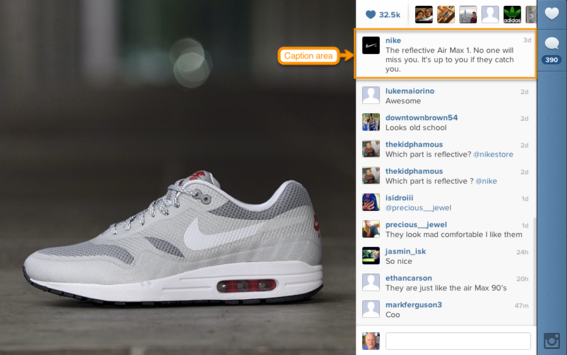Popular photo-sharing app Instagram — which Facebook acquired earlier this year — is now used by businesses. Of 100 leading brands, 54 have incorporated Instagram, according to Simply Measured, an analytics firm.
Here is how you can start using Instagram to market your products and services.
Create Account and User Profile
The first step is to create an Instagram account by downloading the Apple or Android app.
The account creation process includes creating a profile — a username, your company name, a profile image such as your logo, website URL, and 150-character description. You can also, in the account creation process, connect your Instagram account to social networks such as Facebook, Twitter, and others.
Promote the Web-based Profile
Even though it is primarily a mobile application, Instagram recently launched a web-based version of user profiles that resemble those on Pinterest. Here are examples from Nike and Mission Bicycle.

Nike’s Instagram profile.

Web profile of Mission Bicycle.
After you create the account, access the web-based profile at www.instagram.com/yourusername. For example, my profile is at Instagram.com/pchaney.
Like the mobile version, Instagram web profiles allow visitors to follow your company. They can also see the photos that have been uploaded. A link to your company website is also prominently displayed. Be aware that images cannot be uploaded via the web-based profile, only through the mobile app.
The new web profile offers one advantage over the mobile counterpart: a more accessible landing page for visitors.
Since the web profile requires no effort by merchants to create, there is no reason not to draw attention to it. Instagram has designed a series of badges that you can embed on your ecommerce site that links to the profile.

Instagram offers badges for use on websites and blogs.
10 Ways to Use Instagram to Promote Your Business
Once an account has been created and your web-based profile is set up, there are a variety of ways to use Instagram to promote your business and its products or services.
1. Showcase products from your ecommerce catalog. Don’t just upload product images as they appear on your site. Instagram users love the creativity that accompanies the app, so find interesting ways to showcase images. You can use one of the many photo filters the app is famous for, taking pictures of products on warehouse shelves, or by showing employees or customers using the product.
2. Promote new products and sale items. Instagram is an ideal platform for giving customers an sneak peek at new products, or to promote products that are on sale.
3. Add context to your photos. When you take a photo using Instagram, add descriptive content, which Instagram calls “captions.” This could include product information, website URLs, or coupon codes. You could also use the caption area to ask questions and encourage comments, such as Nike did in the screen shot below.

Nike Instagram photo showing caption area.
4. Show how products are made. Merchants who produce their own products can use Instagram to create a series of images showing how the products are made — similar to what t-shirt manufacturer Threadless did in the screen shot below. An app called Pic Stitch allows you to “stitch” the photos together into a single image to create a collage.

Threadless Instagram photo showing how t-shirts are made.
5. Show behind-the-scenes photos. One way to build trust with customers is to let them see what goes on in your company. Instagram enables you to do so with candid imagery.
6. Use relevant hashtags. Similar to Twitter, Instagram utilizes hashtags, which are keywords prefixed with a hash sign — such as #keyword. Hashtags provide a way to categorize images around specific themes. For example, you could associate a hashtag with a series of images focused a particular product line or product category. They also enable you to collect photos from your followers based on a certain theme and connect with like-minded people.
To use hashtags, simply add a hash sign — e.g. #coat — to your photo’s caption, and the photo will be tagged with “Coat.” Users can then click on the hashtag as part of your caption and see the most recent photos tagged with “coat,” including your own.
7. Hold Instagram photo contests. While Instagram does not provide photo contest capabilities, another service called Statigram does. Statigram also includes a feed tab for use on Facebook pages, a Facebook profile cover-creation tool that creates a collage of Instagram images, and a photo gallery widget for use on your website or blog.
Alternatively, you could hold a photo contest using hashtags like General Electric did when it asked followers to take photos inspired by three areas of GE innovation and tag them with #GEinspiredme.
8. Share photos on social networks. Instagram provides users with the ability to share photos on Facebook, Flickr, Twitter, Tumblr, and Foursquare. Users can send photos via email, as well.
9. Involve staff and employees. Encourage employees to share relevant photos they have taken using Instagram. Create specific hashtags for them to use when sharing such photos. This is also a good way to introduce your company to your employee’s followers.
10. Create photos around relevant themes. Don’t just use Instagram to post photos of products. Think about your audience and what it enjoys. Then create relevant photo themes using hashtags.
Conclusion
The web has become much more visual. Instagram continues that trend. Millions of people now use it to express their creativity and share their interests. A business can do the same. Consider using Instagram to tell the story of your brand, create interest among existing and prospective customers, and promote the products you sell.





